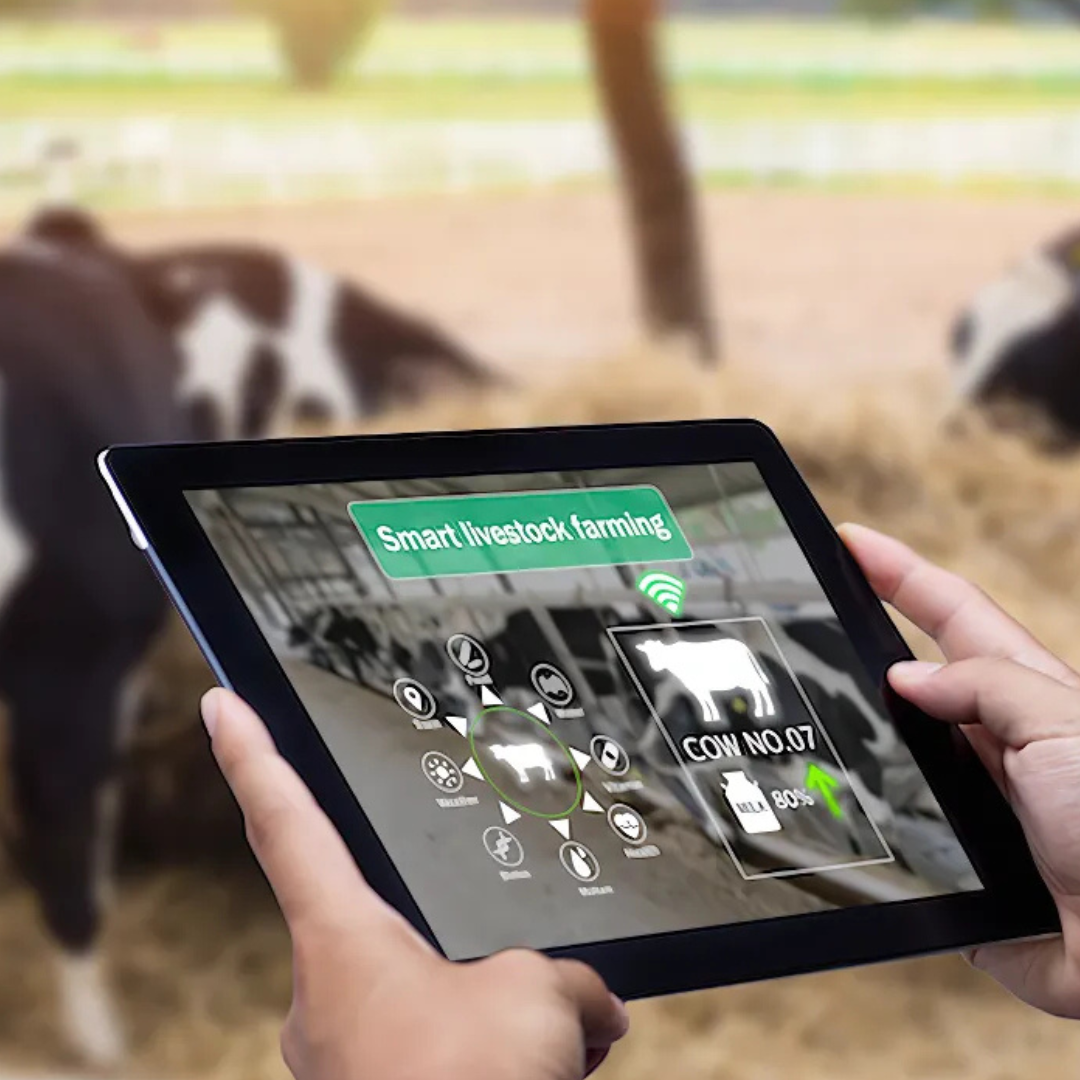Description
Overview of Animal Health Monitoring Using BLE or RFID
Animal health monitoring systems utilizing BLE (Bluetooth Low Energy) or RFID (Radio Frequency Identification) have gained significant traction in modern livestock and wildlife management. These technologies enable continuous, real-time tracking of animal health metrics such as heart rate, body temperature, and movement patterns. BLE allows for low-power, short-range communication, making it ideal for wearable devices that transmit data to a central hub for analysis. RFID, on the other hand, provides efficient identification and tracking of animals over longer distances, especially useful in large farms. By leveraging these technologies, animal health monitoring systems can detect early signs of disease, optimize feeding schedules, and improve overall welfare. Integrating BLE and RFID reduces labor-intensive manual checks and enhances data accuracy, making animal management more efficient and scalable.
Applications in Animal Health Monitoring Using BLE or RFID
- Livestock tracking
- Animal identification
- Disease outbreak monitoring
- Pregnancy detection
- Feed intake monitoring
- Calving alert systems
- Body temperature monitoring
- Heart rate tracking
- Motion detection
- Animal behavior analysis
- Cattle grazing pattern monitoring
- Sheep movement tracking
- Wildlife conservation monitoring
- Early disease detection
- Animal stress level monitoring
- Heat cycle detection
- Animal hydration monitoring
- Medication administration tracking
- Animal quarantine management
- Pasture rotation management
- Swine health monitoring
- Poultry tracking
- Fish farming health monitoring
- Wildlife migration tracking
- Veterinary care optimization
- Animal rest pattern analysis
- Cattle reproductive health monitoring
- Animal herd health management
- Animal isolation management
- Disease transmission tracking
- Animal vaccination compliance tracking
- Animal health forecasting
- Weight monitoring in animals
- Animal growth pattern analysis
- Animal breeding management
- Predator-prey tracking
- Livestock theft prevention
- Animal shelter health monitoring
- Animal behavioral disorder detection
- Cattle water consumption monitoring
Technical Specifications of GAO Tek Animal Health Monitoring Using BLE or RFID
BLE Beacons or RFID tags in Animal Health Monitoring Systems
In animal health monitoring systems, BLE beacons or RFID tags are strategically attached to animals to ensure accurate and efficient data collection. The placement of these devices depends on the species, behavior, and specific health metrics being tracked.
For livestock like cattle, sheep, or goats, RFID tags are commonly affixed to ear tags or collars. Ear tags offer a stable attachment point with minimal discomfort to the animal. They allow for easy identification and tracking without interfering with the animal’s daily activities. Collars with integrated BLE beacons are used for continuous monitoring of vitals like heart rate, temperature, and movement. Collars are especially beneficial in animal health monitoring for large herds, where real-time data is essential for early disease detection.
In poultry, RFID tags can be attached to leg bands or implanted subcutaneously for more discreet monitoring. Implantable RFID tags, although less common, are useful for long-term, internal tracking and are less likely to be lost or damaged.
For wildlife health monitoring, BLE beacons or RFID tags are often integrated into GPS collars to track movement and vital signs remotely. In aquatic environments, BLE beacons can be encased in waterproof devices attached to fins or tails for fish or marine mammal tracking.
The attachment of BLE beacons or RFID tags is designed to minimize discomfort while maximizing data accuracy. The choice of attachment method and location is crucial to ensure the animal health monitoring system remains functional, reliable, and non-invasive across various species.
BLE Gateways or RFID Readers in Animal Health Monitoring Systems
In animal health monitoring systems, BLE gateways and RFID readers are strategically installed to optimize data collection and communication. The placement of these devices is critical for maintaining connectivity, coverage, and data accuracy across the monitoring area.
BLE gateways are typically mounted in central or elevated locations to maximize their range and capture data from BLE beacons attached to animals. For indoor installations, such as barns or livestock pens, BLE gateways are mounted on walls or ceilings to provide unobstructed line-of-sight communication with the beacons. In outdoor settings, gateways are installed on poles or rooftops of buildings to extend the range and ensure reliable data collection in open fields. The number and positioning of gateways depend on the size of the monitoring area, the density of animals, and environmental factors like terrain and obstacles.
RFID readers are often installed at specific points where animals regularly pass through, such as gates, feeding stations, or water troughs. These locations provide natural choke points for reading RFID tags as the animals move through the area. Fixed RFID readers are mounted on walls, gates, or fences to capture data automatically, while handheld readers may be used for more targeted, manual scans. For larger outdoor environments, RFID readers are sometimes integrated into mobile systems, such as drones or vehicles, to cover more ground.
The placement of BLE gateways and RFID readers ensures continuous and real-time data collection, making animal health monitoring systems more efficient and scalable across diverse environments.
Cloud Systems
GAO Cloud BLE or RFID Systems consist of the following parts:
GAO BLE Gateways and Beacons and RFID Readers and Tags
BLE or RFID Cloud, Server, PC & Mobile
GAO Cloud Services Engine for BLE or RFID
Cloud Infrastructure, BLE & RFID Middleware, Data Analytics and Business Intelligence, and Security Measures.
Integration APIs
APIs enable seamless integration between the BLE or RFID solution and existing animal health monitoring systems such as POS, inventory management, and e-commerce platforms, allowing for data exchange and synchronization.
Server, PC & Mobile Systems
GAO Server, PC & Mobile BLE or RFID Systems are composed of
BLE Gateways and Beacons, RFID Tags and Readers
GAO Server, PC & Mobile Software Engine for BLE & RFID
Servers, PCs, Mobile Computing Devices and Infrastructure, Middleware Software, and Database Management System.
Integration with Animal Health Monitoring Systems
The server, PC and mobile solution integrates with existing animal health monitoring systems such as inventory management, point-of-sale (POS), and enterprise resource planning (ERP) systems. Integration is achieved through APIs, database connections, or middleware adapters, enabling seamless data exchange and synchronization.
All GAO’s RFID products are jointly offered by GAO Tek Inc. and its sister company GAO RFID Inc., ranked as a top 10 global RFID and IoT supplier. For RFID products on https://gaotek.com/, please visit RFID-BLE category, and its sub-categories: BLE Gateways, Beacons & Accs, UHF Readers, Tags & Accs, NFC & HF Readers, Tags & Accs, LF Readers, Tags & Accs, and BLE or RFID Cloud, Server, PC & Mobile.
You also are encouraged to visit gaorfid.com that offers a more comprehensive, more complete and different set of BLE & RFID products: BLE, RFID Readers, RFID Tags, Antennas & Accessories, RFID Systems, System By Feature.



